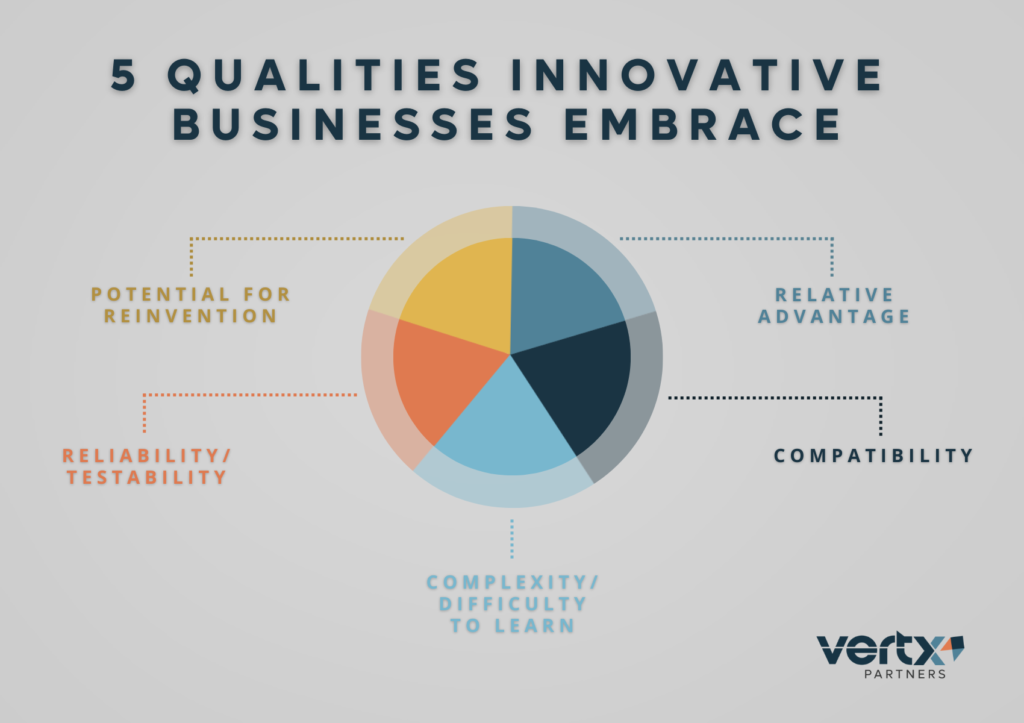‘Innovation’ is a buzzword used often, but what does it really mean? Here, we summarize 5 qualities innovative businesses embrace.

The name ‘Everett Rogers’ doesn’t mean much to most people, but his work in the mid-20th century on the diffusion of innovations defined the characteristics of innovation in the clearest terms. These five characteristics help judge whether innovations are destined for adoption or abandonment. Through the lens of one of history’s most celebrated innovations, the Ford Model T, we examine 5 qualities innovative businesses embrace.

Relative Advantage
The odds are that your innovation isn’t the invention of fire, but instead builds on previous innovations. An assessment of relative advantage is intended to measure how efficient your new solution is compared to current solutions. Henry Ford’s Model T didn’t just do what a horse-and-buggy could do – it could do it much faster. Relative advantage can come in many forms – does your innovation do something faster, more efficient, or more environmentally friendly? Does your innovation shorten the supply chain and save on costs?
Compatibility with the Pre-Existing System
‘Don’t reinvent the wheel.’ The Model T wasn’t lightning in a bottle – it built off a pre-existing system of roadways and the wheel–and–axle. Measuring a solution’s compatibility with the pre-existing system helps determine if you’re maximizing the resources and systems at your disposal. Innovations, again, build off prior breakthroughs. If a solution integrates with minimal upset, more people adopt it.
Complexity/Difficulty to Learn
Imagine a device for achieving universal happiness, but nobody knows how to work it – pretty useless, right? Complexity (or difficulty to learn) takes into consideration how practical your innovation is in the hands of an early adopter. The Model T and its successors departed from the interface of the horse-and-buggy, but they opted to replace it with a mechanical system that could be learned and operated by most: the steering wheel/pedal system. Nowadays, most of us learn how to drive a car by the age of 16. We owe this to the elegant simplicity of this interface. Consider the complexity of your innovation and whether it can realistically be put to use based on interface alone. Most importantly, remember that simplicity (not complexity) is the hallmark of design.
Reliability/Testability
By modern standards, the old Model T doesn’t seem all that reliable, but reliability doesn’t demand perfection. By definition, reliability suggests a margin of error where your innovation doesn’t perform as intended, but the real question stands as is it reliable enough? Reliability/testability seems like a common-sense metric, but it stands as one of the most valuable litmus tests for determining if an innovative idea or product can fulfill its potential. The Model T got people where they needed to go; does your innovation do the same?
Potential for Reinvention
‘Adaptable’ is a word thrown around in business tech jargon, but it’s no buzzword: the ability to adapt can determine the longevity of a product or solution. The world changes faster now than ever before and your innovation should seek to be ahead of the curve. Henry Ford anticipated a world where every middle-class American would have ready access to a cheap and efficient means of personal transportation. Thus, he emphasized the construction of a machine with interchangeable parts and thus the potential for reinvention. Now, there are thousands of varieties of what made the Model T so versatile. Consider versatility by looking beyond mere intent and getting creative with your innovation.
Conclusion
One shouldn’t consider any 1 of the 5 qualities innovative businesses embrace on their own. They all operate in tandem with one another. It is this interaction that determines whether an innovation has what it takes to succeed.
Self-fashioned innovative companies that strive to be ahead of the curve should embody these traits not only in their product but in their execution as a company. Vertx Partners is an innovative company in its approach to tackling complex problems with nonlinear solutions – essentially, flattening out the kinks while networking disparate innovations into a vast web that aids all on board.
Reach out to Vertx to maximize your innovative potential and reap the benefits of this network of partnerships. By putting people together, we’re taking problems apart.
Become an Innovator With Us
Tell us about yourself, answer a few questions, and hit submit. It’s as easy as that to get started.
![5 Qualities Innovative Businesses Embrace [checklist]](https://vertxpartners.org/wp-content/uploads/2021/09/5-Qualities-RP-1-880x360.png)